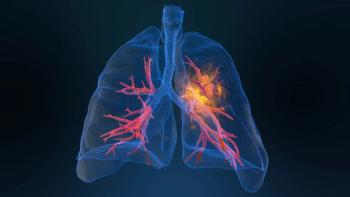
Oncology NEWS International
- Oncology NEWS International Vol 9 No 7
- Volume 9
- Issue 7
Paclitaxel/Carboplatin and Radiation May Double Survival in NSCLC Patients
CHAPEL HILL, NC-In the treatment of non–small-cell lung cancer (NSCLC), combination chemotherapy with paclitaxel (Taxol) and carboplatin (Paraplatin) given before and during radiation therapy may double survival time over that seen with radiation alone.
CHAPEL HILL, NCIn the treatment of nonsmall-cell lung cancer (NSCLC), combination chemotherapy with paclitaxel (Taxol) and carboplatin (Paraplatin) given before and during radiation therapy may double survival time over that seen with radiation alone.
Mark Socinski, MD, from the Multidisciplinary Thoracic Oncology Program at the University of North Carolina, Chapel Hill, announced this finding at the ASCO meeting in New Orleans last May.
A median survival of 26 months was achieved by the use of induction paclitaxel/carboplatin and concurrent chemoradiation in patients with stage III NSCLC. One-year survival for patients in this study was 70%, with an estimated 2-year survival of 51% and 3-year survival of 43%.
The regimen studied optimizes the use of chemotherapy and radiation in a way that increases the survival rate while keeping toxicity to a minimum, Dr. Socinski explained. The survival data reported in this study are better than results that have been reported in the oncology literature to date, he noted.
Most patients with stage III lung cancer are treated with radiation therapy alone, but high doses of radiation typically produce excess toxicity and limit the usefulness of this approach. The median survival is usually around 10 months with radiation alone, with 2-year survival less than 15% in most studies. Survival has been shown to be improved by the addition of chemotherapy to radiotherapy, Dr. Socinski pointed out.
Dose Escalation
This study was conducted in 62 patients with stage IIIA/B NSCLC. The design called for dose escalation of thoracic conformal radiotherapy in combination with paclitaxel/carboplatin.
All patients received two cycles of induction paclitaxel (225 mg/m² over 3 hours every 21 days) plus carboplatin (AUC 6) followed on day 43 by weekly concurrent paclitaxel plus carboplatin (45 mg/m² over 3 hours for 6 days and AUC 2) and thoracic conformal radiotherapy (2 Gy/day) for 50 Gy, with dose escalations in four groups to 60, 66, 70, and 74 Gy.
This combined approach produced responses in 50% of patients: 3% were complete responses and 47% were partial responses. Stable disease was noted in 24% of patients; 16% had progressive disease; and 10% were not evaluable. Median survival (for all 62 patients) was 26 months.
Toxicity was modest, with the primary toxicity being esophagitis. The 11% incidence of grade 3-4 esophagitis was lower than is seen in many other trials, Dr. Socinski noted.
The investigators concluded that with the paclitaxel/carboplatin regimen, the dose of radiation can be escalated without producing a problematic rate of esophagitis, which is often the dose-limiting toxicity experienced by patients undergoing combined-modality therapy.
Articles in this issue
over 25 years ago
Couric Urges Doctors to Talk to Patients About Colon Cancerover 25 years ago
Automated Imaging Notification System Close to Fail-Safeover 25 years ago
Higher Dairy Consumption Linked to Prostate Cancer Riskover 25 years ago
First-Year Funding of Early Detection Research Network Completeover 25 years ago
Gritty Antitobacco Ads and More From Legacy Foundationover 25 years ago
Tositumomab Effective for Low-Grade Follicular Lymphomaover 25 years ago
New Awards Spotlight Courage of Cancer Survivorsover 25 years ago
Hospital Volume Shown to Predict Breast Cancer Outcomeover 25 years ago
New Drug Information Websiteover 25 years ago
NCCN Presents Updated Colorectal Cancer GuidelinesNewsletter
Stay up to date on recent advances in the multidisciplinary approach to cancer.















































































